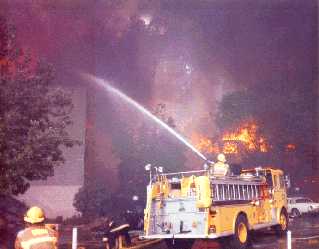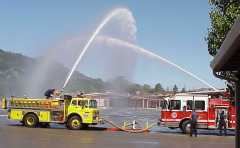© 2000 Capt. Willis Lamm, Water Supply Officer, Moraga-Orinda (CA) Fire DistrictBackground Criteria Storage Distribution Hyd. Design Placement Installation Codes & Markings Applications Codes & Standards
|
| BACKGROUND |
|
Water and fire fighting will always be together. Globally, water is our most plentiful
resource. It is inexpensive. When public water systems are present, it is available
in an almost endless supply. When applied properly, it is very effective in absorbing
heat and extinguishing fires. For these reasons, fire services throughout the world
base their primary operations upon utilizing water as a fire extinguishing agent.
Water and fire hydrant systems involve substantial capital expense, however they typically last between 70 and 100 years. A properly designed and installed system is a long term investment in community safety and should be undertaken utilizing long term planning and appropriate engineering standards. |
Protecting evacuees - 1991 Oakland Firestorm
|
|
The purpose of this information sheet is not to design water and hydrant systems, but rather to present information and raise issues that should be considered by water system planners and designers, especially in small communities or third world countries where relevant fire codes and standards have not been adopted. | |
Background Criteria Storage Distribution Hyd. Design Placement Installation Codes & Markings Applications Codes & Standards
|
| DESIGN CRITERIA |
|
While there are numerous published minimum standards, design criteria for water
systems should be based upon the expected service needs over the life of a
particular system. Storage and water delivery capacities should include
peak domestic consumption combined with peak anticipated fire flows. Storage
capacity should be sufficient to hold two days' peak domestic use plus a minimum
of two hours of peak fire flow in ordinary hazard zones, and a minimum of three
hours (or greater) in high hazard zones.
|
High flow operations
|
|
Calculations for pipe sizing should take into account a minimum of 50 years subsequent
community growth and its increased demands on the system. Pipe materials and installation
criteria should be appropriate for soil conditions which includes issues of soil
stability and seismic activity.
Over the life of a system it is less costly to install a proper system that has sufficient capacity for future community needs to it is to remove and replace pipes every few years. | |
| Continue to Part 2 |
Return to Information Section
Return to Water Supply Page
Background Criteria Storage Distribution Hyd. Design Placement Installation Codes & Markings Applications Codes & Standards
|

